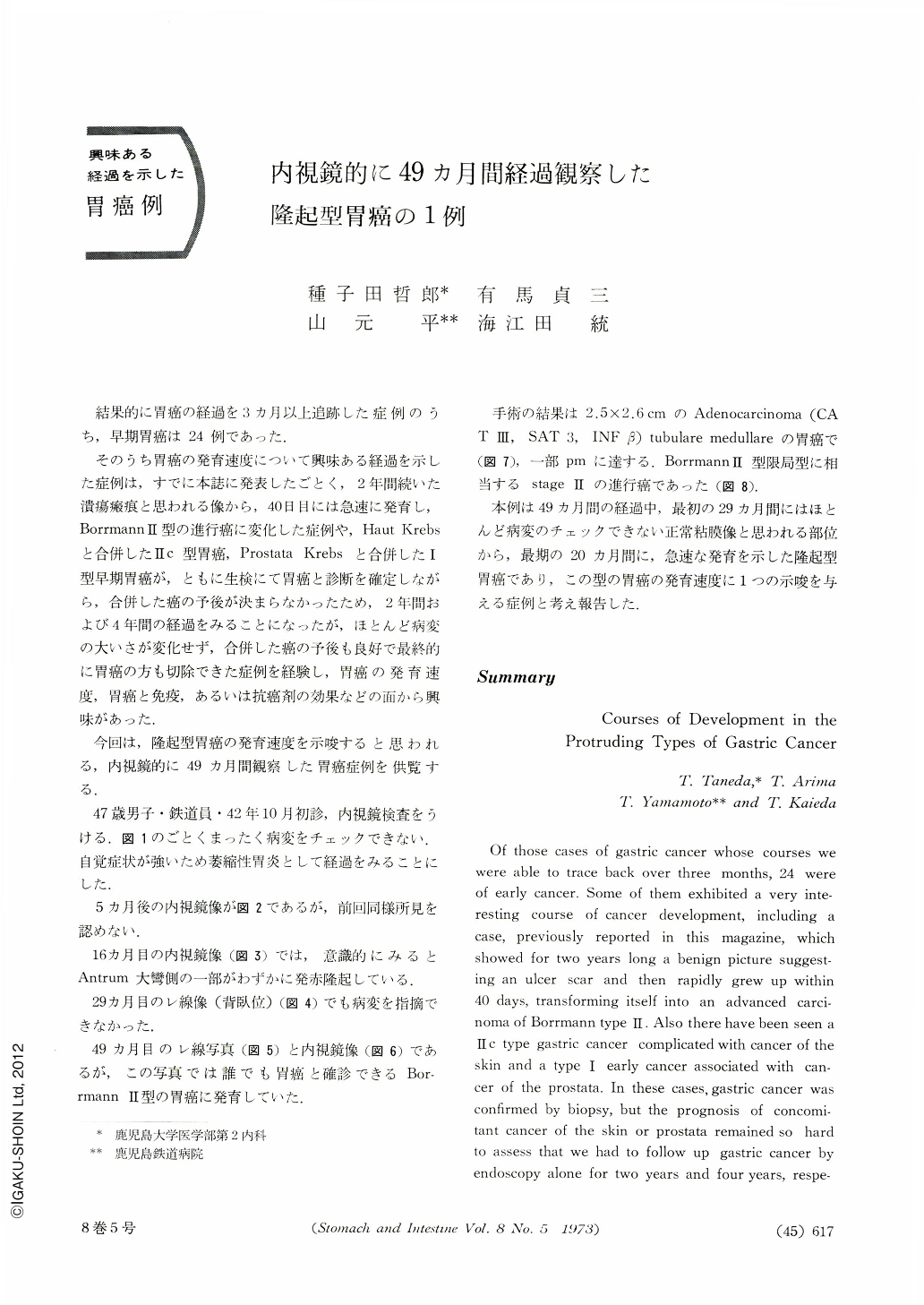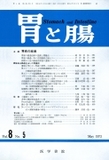Japanese
English
- 有料閲覧
- Abstract 文献概要
- 1ページ目 Look Inside
結果的に胃癌の経過を3カ月以上追跡した症例のうち,早期胃癌は24例であった.
そのうち胃癌の発育速度について興味ある経過を示した症例は,すでに本誌に発表したごとく,2年間続いた潰瘍瘢痕と思われる像から,40日目には急速に発育し,Borrmann Ⅱ型の進行癌に変化した症例や,Haut Krebsと合併したⅡc型胃癌,Prostata Krebsと合併したⅠ型早期胃癌が,ともに生検にて胃癌と診断を確定しながら,合併した癌の予後が決まらなかったため,2年間および4年間の経過をみることになったが,ほとんど病変の大いさが変化せず,合併した癌の予後も良好で最終的に胃癌の方も切除できた症例を経験し,胃癌の発育速度,胃癌と免疫,あるいは抗癌剤の効果などの面から興味があった.
Of those cases of gastric cancer whose courses we were able to trace back over three months, 24 were of early cancer. Some of them exhibited a very interesting course of cancer development, including a case, previously reported in this magazine, which showed for two years long a benign picture suggesting an ulcer scar and then rapidly grew up within 40 days, transforming itself into an advanced carcinoma of Borrmann type Ⅱ. Also there have been seen a Ⅱc type gastric cancer complicated with cancer of the skin and a type Ⅰ early cancer associated with cancer of the prostata. In these cases, gastric cancer was confirmed by biopsy, but the prognosis of concomitant cancer of the skin or prostata remained so hard to assess that we had to follow up gastric cancer by endoscopy alone for two years and four years, respectively. All through the time of follow-up, gastric cancer remained unchanged in size, nor were the prognoses of associating cancers of other viscera unfavorable. We were able to resect the stomach as well without untoward complications. These cases merit our attention, in that they showed us many facets of gastric cancer, including tempo of cancer development, relationship between cancer and immunity and the effects of medications against cancer.
The case described here is that of a 47-year-old railroad-man. First seen in October 1967, he was examined by endoscopy, which revealed no abnormal finding, as is shown in fig. 1. His complaints were so harassing to him that we decided to follow him up as a case of atrophic gastritis. Fig. 2 shows a picture taken five months later. It seemed normal. An endoscopic picture taken 16 months later (fig. 3) showed, on scrutiny, a slightly reddened protrusion on a part in the greater curvature side of the antrum. Supine x-ray picture (fig. 4) taken 29 months later. revealed no abnormal finding. X-ray picture (fig. 5) and endoscopic picture (fig. 6) exposed 49 months after the first examination unquestionably showed advanced carcinoma of Borrmann type Ⅱ.
Resected specimen showed that cancer was adeno-carcinoma tubulare medullare, 2.5 by 2.6 cm (CAT Ⅲ, SAT 3, INF α), partly reaching the muscularis propriae. It was advanced carcinoma in the stage Ⅱ, corresponding to localized type, or type Ⅱ according to Borrmann's classification.
This case reems to throw some light on the rate of speed of cancer development in the protruding variety, because during the 29 long months from the onset hardly abny abnormality was to be seen and in the course of subsequent 20 months rapidly grown cancer was demonstrated.

Copyright © 1973, Igaku-Shoin Ltd. All rights reserved.


